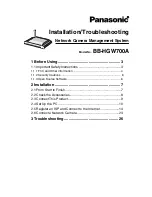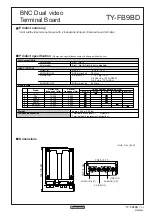
TB8100 Service Kit User’s Manual
Working with Channel Profiles 121
Power Saving
In the Add or Edit Channel Profile dialog box, the Power Saving tab lets you
configure power saving. A graph shows the meaning of
Rx Sniff
,
Rx cycling
,
and
Tx keyup
. The three areas below the graph define the parameters for
Normal, Sleep, and Deep Sleep modes.
Sleep and Deep Sleep modes require a
Power Saving Modes license and only occur when the base station is running
on battery power.
Power saving involves switching off parts of the base station circuitry. For
details see the Installation and Operation manual. To determine the parameter
settings needed for a given level of power consumption, refer to the
Specifications manual.
Normal
Defines how the base station operates normally. Normal mode can involve a
degree of power saving.
Sleep
The Sleep check box enables Sleep mode. The related group box defines how
the base station operates in Sleep mode. A base station enters Sleep mode when
the receiver has been idle for the length of time specified in the Sleep mode’s
Start after
box.
Deep Sleep
The Deep Sleep check box enables Deep Sleep mode. The related group box
defines how the base station operates in Deep Sleep mode. A base station enters
Deep Sleep mode when the receiver has been idle for the length of time
specified in the Deep Sleep mode’s
Start after
box.
Rx cycling
Rx cycling is the length of time in milliseconds that the receiver is switched off
for.
Power saving is effected by switching off the receiver, switching it back on for
an ‘Rx sniff’ to check if there is a valid signal, switching it off again, and so on.
Rx cycling is the length of time that the receiver is switched off for.
Summary of Contents for TB8100
Page 1: ...TB8100 base station Service Kit User s Manual MBA 00010 08 Issue 8 December 2007...
Page 8: ...vi Contents Tait Electronics Limited December 2007...
Page 12: ...2 Introduction Tait Electronics Limited December 2007...
Page 26: ...16 Part A Introduction Tait Electronics Limited December 2007...
Page 28: ...18 Getting Started Tait Electronics Limited December 2007...
Page 38: ...28 Part B Getting Started Tait Electronics Limited December 2007...
Page 40: ...30 Basic Tasks Tait Electronics Limited December 2007...
Page 74: ...64 Part C Basic Tasks Tait Electronics Limited December 2007...
Page 76: ...66 Monitoring Tait Electronics Limited December 2007...
Page 88: ...78 Part D Monitoring Tait Electronics Limited December 2007...
Page 90: ...80 Configuring the Base Station Tait Electronics Limited December 2007...
Page 106: ...96 Part E Configuring the Base Station Tait Electronics Limited December 2007...
Page 108: ...98 Configuring Channels Tait Electronics Limited December 2007...
Page 154: ...144 Part F Configuring Channels Tait Electronics Limited December 2007...
Page 156: ...146 Alarms Tait Electronics Limited December 2007...
Page 176: ...166 Part G Alarms Tait Electronics Limited December 2007...
Page 178: ...168 Diagnosing Tait Electronics Limited December 2007...
Page 198: ...188 Part H Diagnosing Tait Electronics Limited December 2007...
Page 200: ...190 Task Manager Tait Electronics Limited December 2007...
Page 254: ...244 Tait General Software Licence Agreement Tait Electronics Limited December 2007...
















































